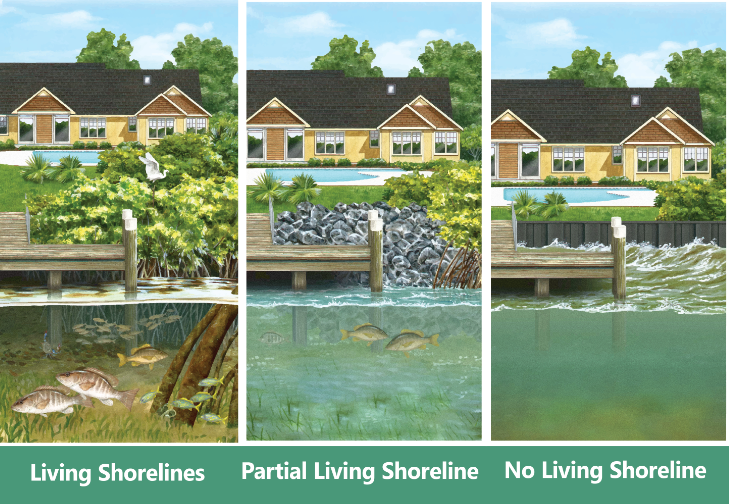Living Shorelines Program
Protect Your Property & Help the Environment
Living shorelines use natural elements such as oyster reefs, marsh grasses and mangroves to protect shorelines from erosion. Unlike a concrete seawall or other hard structures, which impede the growth of plants and animals, living shorelines grow over time. They are an innovative and cost-effective technique for coastal management.
Living shorelines have many benefits over traditional seawalls. Living shorelines:
- Absorb and break up wave energy.
- Reduce shoreline erosion from wave energy and during storm events.
- Improve water clarity and filters pollutants.
- Provide habitat for fish, wading birds and other animals.
- Offers a less expensive, more sustainable option to traditional seawalls.
Living Shoreline Elements

Mangroves
Mangroves protect property from severe wind damage and wave energy. They provide habitat for fish and shellfish, shelter for a variety of birds, and even nectar for bees. Lastly, they improve water quality by absorbing nutrients from runoff that might otherwise cause harmful algal blooms.
Grasses
Grasses that grow along shorelines provide habitat and create a buffer that reduces wave energy and associated erosion. Grass roots capture sediment and filter nutrients from stormwater runoff.
Oysters
Oysters are filter-feeders, drawing water in and trapping small bits of algae and nutrients from the water column. This filtering process increases water clarity and improves water quality. An adult oyster can filter more than 50 gallons of water per day! Learn more about our Oyster Shell Recycling Pilot Program.
What Can You Do?
If you have a seawall, you can still add living shoreline elements in front of it. You’ll extend the life of your seawall and see many other benefits.

Additional Resources
- Visit living shorelines in Pinellas County.
- Learn more about permitting, cost and installations at FloridaLivingShorelines.com.
For general information and Pinellas County permitting, please email watershed@pinellas.gov.